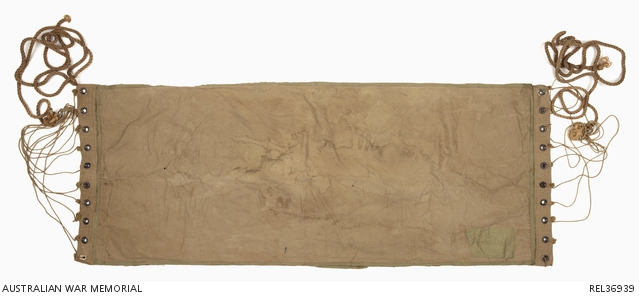| Place | Oceania: New Guinea1 |
|---|---|
| Accession Number | REL36939 |
| Collection type | Heraldry |
| Object type | Personal Equipment |
| Physical description | Brass, Cotton, Cotton drill, Rope, Twine |
| Maker |
American Pad & Textile Company |
| Place made | United States of America |
| Date made | 1942 |
| Conflict |
Second World War, 1939-1945 |
US Army issue jungle hammock : Sergeant A G Dyne MM, 2/12 Battalion, AIF



US Army issue hammock (officially known as a 'Hammock, Jungle, Complete') with mosquito net. The waterproof overhead fly sheet has been removed from the mosquito netting and is not present. The hammock comprises an olive green cotton drill sheet with ten brass suspension eyelets at each end. Lengths of cord looped through these eyelets are gathered at a ring from which the entire structure is slung using the length of rope. The mosquito netting has been cut from the sleeping section to which it was originally attached, possibly to make it easier for the user to get out of the hammock. Written in black ink at each end of the sleeping section is, 'ALF DYNE YANDINA'. A maker's label is sewn into a waterproof pocket attached to the sleeping section. On the label is printed, 'HAMMOCK JUNGLE COMPLETE AMERICAN PAD & TEXTILE CO. 10/31/42 W669QM-22592 SPEC. P.Q.D. NO.356A STOCK NO. 74-H-60 PHILADELPHIA Q.M.D.'. Attached to the underside of the hammock are a pair of cotton webbing loops with press-stud fastenings. These were intended to allow a rifle to be slung beneath the occupant, protecting it from rain.The netting canopy has a brown cotton roof and is enclosed around four sides by green mosquito netting. The lower portions of the net areas are of a light cotton fabric.
The 'Hammock, Jungle, Complete' was issued to US Army personnel operating in tropical climates during the 1940s, and was designed to be used either as a conventional hammock when suspended between trees, or as a small insect-proof tent if placed upon the ground with poles to support the fly. This example was used by QX21910 Sergeant A G Dyne MM, 2/12 Battalion, AIF. Born at Yandina, Queensland on 31 August 1920, Alfred Gould Dyne was working as a labourer and serving with the militia when he enlisted in the AIF on 1 July 1941. Private Dyne embarked at Melbourne in September 1941 with reinforcements to the 2/12th Battalion and joined the battalion at Julis Camp, Palestine (near Ashkelon in modern-day Israel) in January 1942. The next month, Dyne embarked with the 2/12th Battalion aboard HT Nieu Amsterdam for Bombay and from there on to Australia aboard HT Dilwara; arriving in Adelaide in late March 1942. Dyne saw action at Milne Bay in August 1942 and later in the year was awarded the Military Medal for his actions during the fighting at Buna, Soputa and Sanananda. The citation reads, 'This NCO has given consistent proof of his gallantry and devotion to duty during the New Guinea Campaign. During the BUNA action Sgt Dyne was commanding a section when his Pl [platoon] Cmd [commander] and senior NCO's became casualties; he took over command of the Pl and displayed great leadership in moving the Pl forward under heavy fire to a position from where he was able to bring fire to bear on the enemies' flank; although the platoon suffered heavy casualties he refused to withdraw - his action played an important part in that phase of the battle. During the SOPUTA action Dyne again took over command of 13 Platoon when his Pl Comd was killed; in this action and again at SANANANDA he displayed great personal courage: his leadership, initiative and energy had a marked effect upon all those under his command.'. Suffering from malaria throughout his service, Sergeant Dyne continued to serve with the 2/12th Battalion in its campaigns in Papua New Guinea and Borneo. Sergeant Dyne received his discharge on 27 November 1945.